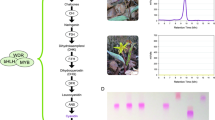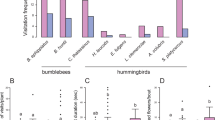Abstract
The role of major mutations in adaptive evolution has been debated for more than a century1,2. The classical view is that adaptive mutations are nearly infinite in number with infinitesimally small phenotypic effect3, but recent theory suggests otherwise4. To provide empirical estimates of the magnitude of adaptive mutations in wild plants, we conducted field studies to determine the adaptive value of alternative alleles at a single locus, YELLOW UPPER5,6,7 (YUP). YUP controls the presence or absence of yellow carotenoid pigments in the petals of pink-flowered Mimulus lewisii, which is pollinated by bumblebees5,8,9,10, and its red-flowered sister species11 M. cardinalis, which is pollinated by hummingbirds5,8,9,10. We bred near-isogenic lines (NILs) in which the YUP allele from each species was substituted into the other. M. cardinalis NILs with the M. lewisii YUP allele had dark pink flowers and received 74-fold more bee visits than the wild type, whereas M. lewisii NILs with the M. cardinalis yup allele had yellow-orange flowers and received 68-fold more hummingbird visits than the wild type. These results indicate that an adaptive shift in pollinator preference may be initiated by a single major mutation.
This is a preview of subscription content, access via your institution
Access options
Subscribe to this journal
Receive 51 print issues and online access
$199.00 per year
only $3.90 per issue
Buy this article
- Purchase on Springer Link
- Instant access to full article PDF
Prices may be subject to local taxes which are calculated during checkout

Similar content being viewed by others
References
Orr, H. A. & Coyne, J. A. The genetics of adaptation: a reassessment. Am. Nat. 140, 725–742 (1992)
Gillham, N. W. Evolution by jumps: Francis Galton and William Bateson and the mechanism of evolutionary change. Genetics 159, 1383–1392 (2001)
Fisher, R. A. The Genetical Theory of Natural Selection (Dover, New York, 1958)
Orr, H. A. The population genetics of adaptation: the distribution of factors fixed during adaptive evolution. Evolution 52, 935–949 (1998)
Hiesey, W. M., Nobs, M. A. & Björkman, O. Experimental Studies on the Nature of Species: V. Biosystematics, Genetics, and Physiological Ecology of the Erythranthe Section of Mimulus 16 (Carnegie Inst. Wash. Publ. 628, Washington DC, 1971)
Bradshaw, H. D. Jr, Wilbert, S. M., Otto, K. G. & Schemske, D. W. Genetic mapping of floral traits associated with reproductive isolation in monkeyflowers (Mimulus). Nature 376, 762–765 (1995)
Bradshaw, H. D. Jr, Otto, K. G., Frewen, B. E., McKay, J. K. & Schemske, D. W. Quantitative trait loci affecting differences in floral morphology between two species of monkeyflower (Mimulus). Genetics 149, 367–382 (1998)
Schemske, D. W. & Bradshaw, H. D. Jr Pollinator preference and the evolution of floral traits in monkeyflowers (Mimulus). Proc. Natl Acad. Sci. USA 96, 11910–11915 (1999)
Ramsey, J., Bradshaw, H. D. Jr & Schemske, D. W. Components of reproductive isolation between the monkeyflowers Mimulus lewisii and M. cardinalis (Phrymaceae). Evolution 57, 1520–1534 (2003)
Vickery, R. K. Jr Speciation in Mimulus, or, can a simple flower color mutant lead to species divergence? Great Basin Nat. 55, 177–180 (1995)
Beardsley, P. M., Yen, A. & Olmstead, R. G. AFLP phylogeny of Mimulus section Erythranthe and the evolution of hummingbird pollination. Evolution 57, 1397–1410 (2003)
Mauricio, R. Mapping quantitative trait loci in plants: uses and caveats for evolutionary biology. Nature Rev. Genet. 2, 370–381 (2001)
Hodges, S. A., Whittall, J. B., Fulton, M. & Yang, J.-Y. Genetics of floral traits influencing reproductive isolation between Aquilegia formosa and Aquilegia pubescens. Am. Nat. 159, S51–S60 (2002)
Grant, V. Historical development of ornithophily in the western North American flora. Proc. Natl Acad. Sci. USA 91, 10407–10411 (1994)
Acknowledgements
We thank A. Angert, K. Kay, and D. Grosenbacher for field observations of pollinators, P. Beardsley and S. Stefanovic for field assistance, and B. Watson for genotyping. We are grateful to F. Nicholson and the Carnegie Institution of Washington for allowing us to use the Mather field station. Y. Sam provided helpful comments on the manuscript. This work was supported by an award from the National Science Foundation.
Author information
Authors and Affiliations
Corresponding author
Ethics declarations
Competing interests
The authors declare that they have no competing financial interests.
Rights and permissions
About this article
Cite this article
Bradshaw, H., Schemske, D. Allele substitution at a flower colour locus produces a pollinator shift in monkeyflowers. Nature 426, 176–178 (2003). https://doi.org/10.1038/nature02106
Received:
Accepted:
Issue Date:
DOI: https://doi.org/10.1038/nature02106
This article is cited by
-
Rapid genomic evolution in Brassica rapa with bumblebee selection in experimental evolution
BMC Ecology and Evolution (2024)
-
Ecotype variation in the endemic tree Callicarpa subpubescens on small oceanic islands: genetic, phenotypic, and environmental insights
Heredity (2024)
-
Flavonoid Myricetin as Potent Anticancer Agent: A Possibility towards Development of Potential Anticancer Nutraceuticals
Chinese Journal of Integrative Medicine (2024)
-
NtERF4 promotes the biosynthesis of chlorogenic acid and flavonoids by targeting PAL genes in Nicotiana tabacum
Planta (2024)
-
Balancing selection on an MYB transcription factor maintains the twig trichome color variation in Melastoma normale
BMC Biology (2023)
Comments
By submitting a comment you agree to abide by our Terms and Community Guidelines. If you find something abusive or that does not comply with our terms or guidelines please flag it as inappropriate.



